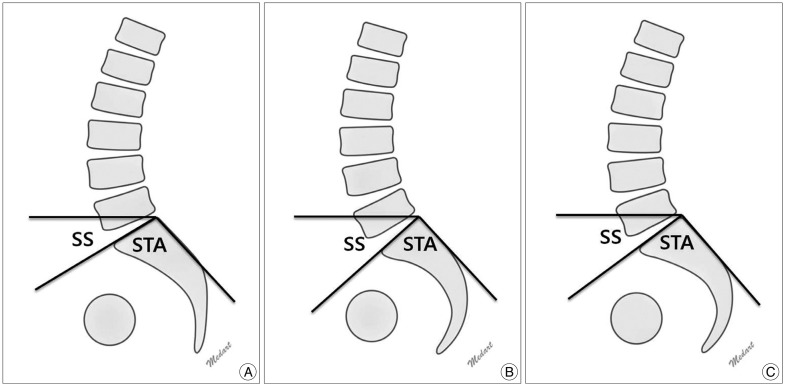J Korean Neurosurg Soc.
2013 Sep;54(3):207-210. 10.3340/jkns.2013.54.3.207.
The Comparison of Sagittal Spinopelvic Parameters between Young Adult Patients with L5 Spondylolysis and Age-Matched Control Group
- Affiliations
-
- 1Department of Neurosurgery, Research Institute of Clinical Medicine of Chonbuk National University, Biomedical Research Institute of Chonbuk National University Hospital, Jeonju, Korea. spineeun@jbnu.ac.kr
- KMID: 2190899
- DOI: http://doi.org/10.3340/jkns.2013.54.3.207
Abstract
OBJECTIVE
To compare spinopelvic parameters in young adult patients with spondylolysis to those in age-matched patients without spondylolysis and investigate the clinical impact of sagittal spinopelvic parameters in patients with L5 spondylolysis.
METHODS
From 2009 to 2012, a total of 198 young adult male patients with spondylolysis were identified. Eighty age-matched patients without spondylolysis were also selected. Standing lateral films that included both hip joints were obtained for each subject. Pelvic incidence (PI), sacral slope (SS), pelvic tilt, lumbar lordosis angle, sacral inclination, lumbosacral angle, and sacral table angle were measured in both groups. A comparative study of the spinopelvic parameters of these two groups was performed using SPSS 15.0 (SPSS Inc., Chicago, IL, USA).
RESULTS
Among the aforementioned spinopelvic parameters, PI, SS and STA were significantly different between patients with spondylolysis and those without spondylolysis. PI and SS were higher in the spondylolysis group than in the control group, but STA was lower in the spondylolysis group than in the control group.
CONCLUSION
PI and SS were higher in the spondylolysis group than in the control group, but STA was lower in the spondylolysis group than in the control group. Patients with spondylolysis have low STA at birth, which remains constant during growth; a low STA translates into high SS. As a result, PI is also increased in accordance with SS. Therefore, we suggest that STA is an important etiologic factor in young adult patients with L5 spondylolysis.
Keyword
MeSH Terms
Figure
Reference
-
1. Dubousset J. Treatment of spondylolysis and spondylolisthesis in children and adolescents. Clin Orthop Relat Res. 1997; 77–85. PMID: 9137179.
Article2. Endo K, Suzuki H, Tanaka H, Kang Y, Yamamoto K. Sagittal spinal alignment in patients with lumbar disc herniation. Eur Spine J. 2010; 19:435–438. PMID: 20091188.
Article3. Hresko MT, Labelle H, Roussouly P, Berthonnaud E. Classification of high-grade spondylolistheses based on pelvic version and spine balance : possible rationale for reduction. Spine (Phila Pa 1976). 2007; 32:2208–2213. PMID: 17873812.
Article4. Inoue H, Ohmori K, Miyasaka K. Radiographic classification of L5 isthmic spondylolisthesis as adolescent or adult vertebral slip. Spine (Phila Pa 1976). 2002; 27:831–838. PMID: 11935105.
Article5. Labelle H, Mac-Thiong JM, Roussouly P. Spino-pelvic sagittal balance of spondylolisthesis : a review and classification. Eur Spine J. 2011; 20(Suppl 5):641–646. PMID: 21809015.
Article6. Labelle H, Roussouly P, Berthonnaud E, Dimnet J, O'Brien M. The importance of spino-pelvic balance in L5-s1 developmental spondylolisthesis : a review of pertinent radiologic measurements. Spine (Phila Pa 1976). 2005; 30(6 Suppl):S27–S34. PMID: 15767882.7. Labelle H, Roussouly P, Berthonnaud E, Transfeldt E, O'Brien M, Chopin D, et al. Spondylolisthesis, pelvic incidence, and spinopelvic balance : a correlation study. Spine (Phila Pa 1976). 2004; 29:2049–2054. PMID: 15371707.8. Legaye J, Duval-Beaupère G, Hecquet J, Marty C. Pelvic incidence : a fundamental pelvic parameter for three-dimensional regulation of spinal sagittal curves. Eur Spine J. 1998; 7:99–103. PMID: 9629932.
Article9. Mac-Thiong JM, Wang Z, de Guise JA, Labelle H. Postural model of sagittal spino-pelvic alignment and its relevance for lumbosacral developmental spondylolisthesis. Spine (Phila Pa 1976). 2008; 33:2316–2325. PMID: 18827698.
Article10. Mehta VA, Amin A, Omeis I, Gokaslan ZL, Gottfried ON. Implications of spinopelvic alignment for the spine surgeon. Neurosurgery. 2012; 70:707–721. PMID: 21937939.
Article11. Osterman K, Osterman H. Experimental lumbar spondylolisthesis in growing rabbits. Clin Orthop Relat Res. 1996; 274–280. PMID: 8913172.12. Roussouly P, Gollogly S, Berthonnaud E, Dimnet J. Classification of the normal variation in the sagittal alignment of the human lumbar spine and pelvis in the standing position. Spine (Phila Pa 1976). 2005; 30:346–353. PMID: 15682018.
Article13. Roussouly P, Gollogly S, Berthonnaud E, Labelle H, Weidenbaum M. Sagittal alignment of the spine and pelvis in the presence of L5-s1 isthmic lysis and low-grade spondylolisthesis. Spine (Phila Pa 1976). 2006; 31:2484–2490. PMID: 17023859.
Article14. Stagnara P, De Mauroy JC, Dran G, Gonon GP, Costanzo G, Dimnet J, et al. Reciprocal angulation of vertebral bodies in a sagittal plane : approach to references for the evaluation of kyphosis and lordosis. Spine (Phila Pa 1976). 1982; 7:335–342. PMID: 7135066.
Article15. Vialle R, Ilharreborde B, Dauzac C, Lenoir T, Rillardon L, Guigui P. Is there a sagittal imbalance of the spine in isthmic spondylolisthesis? A correlation study. Eur Spine J. 2007; 16:1641–1649. PMID: 17437136.
Article16. Vialle R, Levassor N, Rillardon L, Templier A, Skalli W, Guigui P. Radiographic analysis of the sagittal alignment and balance of the spine in asymptomatic subjects. J Bone Joint Surg Am. 2005; 87:260–267. PMID: 15687145.
Article17. Wang Z, Parent S, Mac-Thiong JM, Petit Y, Labelle H. Influence of sacral morphology in developmental spondylolisthesis. Spine (Phila Pa 1976). 2008; 33:2185–2191. PMID: 18794760.
Article18. Whitesides TE Jr, Horton WC, Hutton WC, Hodges L. Spondylolytic spondylolisthesis : a study of pelvic and lumbosacral parameters of possible etiologic effect in two genetically and geographically distinct groups with high occurrence. Spine. 2005; 30:S12–S21. PMID: 15767879.
- Full Text Links
- Actions
-
Cited
- CITED
-
- Close
- Share
- Similar articles
-
- Correlation Between the Spinopelvic Parameters and Morphological Characteristics of Pedicle-Facet Joints in Different Lumbar Spondylolisthesis
- Sagittal MR Findings of L5 Spondylolysis: Changes of Spinal Canal
- Sacropelvic Parameters and L5 Spondylolysis: Computed Tomography Analysis
- Factors Associated with the Symptoms of Young Adults with L5 Spondylolysis
- Segmental Lordosis of the Spondylolytic Vertebrae in Adolescent Lumbar Spondylolysis: Differences between Bilateral L5 and L4 Spondylolysis


